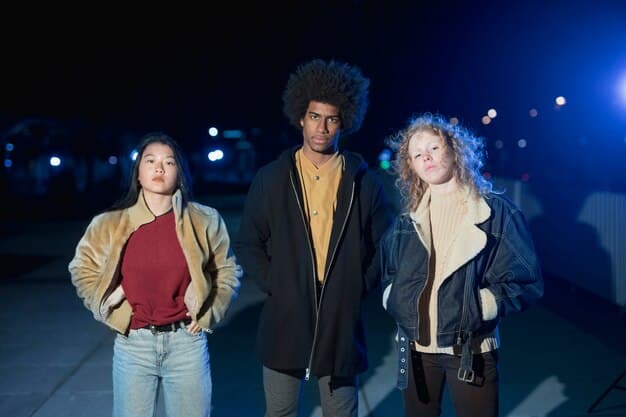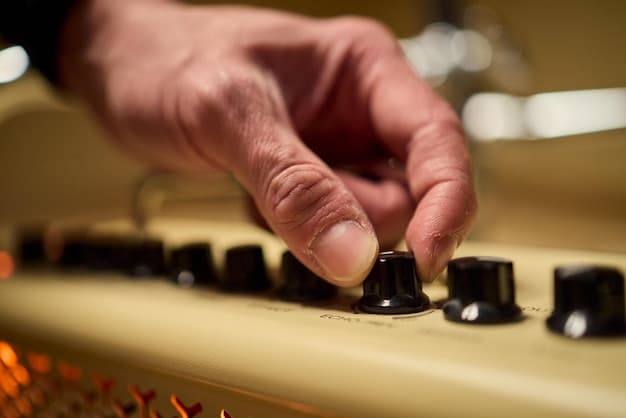Underground Music Royalties: Fairness in US Streaming?

The question of whether streaming services fairly compensate underground artists in the US highlights a complex landscape of low per-stream payouts, opaque royalty distribution, and the disproportionate impact on lesser-known creators striving for financial viability in a digitally reliant music industry.
In the evolving landscape of digital music, a critical question resonates among independent artists: Is the compensation from streaming services truly equitable for underground musicians in the US? This inquiry unpacks the hidden complexities of royalty distribution, aiming to shed light on a system often criticized for its opaqueness and perceived unfairness.
the streaming economy: a brief overview
The dawn of digital streaming revolutionized music consumption, shifting from physical sales and downloads to an on-demand, subscription-based model. This transformation, while offering unparalleled access for listeners, introduced a new paradigm for artist compensation, heavily reliant on complex royalty structures.
Initially hailed as the savior of a struggling music industry grappling with piracy, streaming platforms rapidly became the primary conduit for music distribution. Spotify, Apple Music, and Amazon Music, among others, now dominate the market, boasting billions of streams daily. However, the sheer volume of consumption doesn’t automatically translate to substantial earnings for every artist.
how streaming royalties are calculated
Understanding how streaming royalties are calculated is crucial, yet often perplexing. Unlike traditional sales where a fixed price is paid per unit, streaming royalties are derived from a complex formula influenced by numerous variables. These include the total revenue generated by the platform (from subscriptions and advertising), the total number of streams across all artists, the artist’s agreement with their distributor or label, and geographic factors.
- Per-stream payout rates: These vary significantly by platform, ranging from fractions of a cent to slightly over a cent. These rates are not fixed and can fluctuate based on the platform’s overall revenue and the specific type of subscription (e.g., premium vs. ad-supported).
- Pro-rata system: Most major streaming services operate on a “pro-rata” or “market share” model. This means that a platform tallies all the money it earns in a given period, calculates the total number of streams, and then allocates a percentage of that revenue to rights holders based on their share of total streams.
- Rights holders: The money generated isn’t paid directly to artists. Instead, it goes to various rights holders: record labels (for sound recording ownership), publishers (for composition ownership), and, eventually, songwriters and artists, often after multiple deductions.
This multi-layered distribution pipeline means that by the time royalties reach underground artists, especially those without major label backing, the amounts can be exceedingly small, making it difficult to generate meaningful income solely from streaming.
the plight of underground artists
While global superstars might accumulate millions from streaming, the reality for underground artists is markedly different. These creators, often operating without the financial support or promotional machinery of major labels, face an uphill battle in a system not designed to favor niche or emerging talent.
Underground music, by its very nature, thrives on discovery, community, and authenticity. Artists in genres like avant-garde electronic, experimental rock, indie hip-hop, or noise are often driven by artistic expression rather than commercial aspiration. Yet, recognition and a sustainable career still require some financial viability, which streaming platforms largely fail to provide.
challenges specific to independent creators
Independent artists confront a unique set of challenges that exacerbate the issue of low streaming royalties. Without the bargaining power of a major label, their agreements with distributors often result in less favorable terms, leading to a smaller percentage of an already meager per-stream payout.
- Lack of transparency: The opaque nature of royalty calculations is a constant source of frustration. Artists often receive lump-sum payments or complex statements that offer little clarity on how their earnings were derived, making it hard to verify fairness.
- Discovery versus compensation: While streaming platforms offer unparalleled global reach and discovery opportunities, this benefit is often viewed as a trade-off for equitable compensation. Artists gain exposure but struggle to convert that into sustainable income.
- Financial strain: For many underground artists, every cent counts. Low streaming revenue means less money to invest back into their craft—be it for studio time, equipment, touring, or marketing. This can stifle artistic growth and force talented individuals out of music altogether.
The fundamental issue here lies in the disproportionate reward system. A single stream by a top-tier artist generates the same per-stream revenue as one by an underground artist, but the sheer volume differences mean the established acts dominate payouts, leaving little for the burgeoning talent pool.

the royalty distribution maze: who gets what?
The journey of a dollar earned from a stream to an artist’s pocket is a convoluted one, passing through multiple gatekeepers, each taking a cut. Understanding this pipeline is crucial to comprehending why artists, particularly those in the underground scene, often see so little of the pie.
When a song is streamed, the revenue generated does not flow directly from the streaming service to the artist. Instead, it’s divided between two primary types of rights: the sound recording (also known as the master recording) and the musical composition.
sound recording royalties
The bulk of streaming revenue, typically around 50-60%, goes to the sound recording owners. For most mainstream artists, this is their record label. For independent and underground artists, this could be their self-owned label, an independent distributor, or even themselves if they handle everything independently.
- Record labels/distributors: These entities typically take a significant percentage, often 70-85% or more, of the sound recording royalties, according to their agreements with the artist. What’s left is what the artist receives.
- Per-stream rates: It’s important to reiterate that the per-stream rates mentioned earlier (fractions of a cent) are what the streaming service pays to the rights holder (label/distributor), not what the artist ultimately receives. The artist’s actual per-stream rate is even lower after deductions.
musical composition royalties
The remaining portion of streaming revenue (typically 10-15%) is allocated to musical composition royalties. These are paid to the copyright owners of the underlying song – the songwriter(s) and publisher(s).
- Performance royalties: Paid to songwriters and publishers when a song is publicly performed (including digital streams). In the US, these are collected and distributed by Performing Rights Organizations (PROs) like ASCAP, BMI, and SESAC.
- Mechanical royalties: Paid to songwriters and publishers when a musical composition is reproduced. For interactive streaming (where listeners choose specific songs), both performance and mechanical royalties are triggered. Mechanical royalties are collected by agencies like the Mechanical Licensing Collective (MLC) in the US.
For independent artists who are also their own songwriters and publishers, they are eligible for both sound recording and musical composition royalties. However, navigating these separate streams and ensuring all due payments are collected can be a complex administrative burden, often requiring specialized knowledge or third-party services that also take a percentage.
fair compensation or market reality? arguments and counterarguments
The debate around fair compensation in streaming is multifaceted, with various stakeholders presenting compelling arguments. Understanding these perspectives is key to grasping the complexity of the issue.
arguments for current system’s fairness (from streaming services and labels)
Streaming services often argue that their model is the most sustainable and efficient way to distribute music in the digital age. They highlight the vast reach and promotional benefits they offer to artists, particularly those who might not otherwise gain exposure.
- Scale and reach: Platforms argue they democratize music by making it accessible globally, allowing underground artists to reach niche audiences they couldn’t through traditional radio or retail. This “discovery” value is often cited as compensation in itself.
- Operating costs: Running a global streaming service involves massive technological infrastructure, licensing fees, marketing, and staffing. They argue that their per-stream payouts reflect these significant operating costs and the need for profitability.
- Evolution of consumption: The industry has shifted from purchasing individual units to consuming large volumes via subscription. They argue that artists are now compensated for volume of consumption rather than discrete sales, reflecting modern consumer behavior.
Major record labels, while often negotiating for higher rates from streaming services, largely benefit from the current pro-rata system, as their vast catalogs and established artists dominate stream counts. They claim their role in artist development, marketing, and upfront investment justifies their share of royalties.
arguments against current system’s fairness (from artists and advocates)
Artists and artist advocacy groups contend that the current system disproportionately favors streaming platforms and major labels, leaving independent creators with scraps. They argue that the model undervalues the creative work itself.
- Low per-stream rates: The fundamental issue is that per-stream rates are too low to sustain a career for most artists. Critics argue that even millions of streams may not yield a living wage, especially after various cuts.
- Opacity and complexity: The lack of transparent reporting and the labyrinthine royalty mechanics make it nearly impossible for artists to understand or audit their earnings, fostering distrust.
- Unequal distribution: The pro-rata model means a disproportionate amount of revenue flows to the most-streamed artists and their rights holders. This creates a winner-take-all scenario where the long tail of independent artists struggles to earn anything significant.
- Ethical considerations: Many artists feel their intellectual property is being devalued. They contend that the cultural and artistic value they provide is not adequately reflected in their financial compensation, challenging the premise that “exposure” is sufficient payment.
Alternative models, such as user-centric payment systems (UCPS), where artist royalties are based on what their individual fans listen to rather than a market share of all streams, are gaining traction as potential fairer solutions, though major platforms have been slow to adopt them.
innovations and alternative models beyond traditional streaming
The dissatisfaction with traditional streaming royalties has spurred innovation, leading to the emergence of alternative platforms and compensation models designed to offer artists a more equitable share. Underground artists, often early adopters of new technologies, are at the forefront of exploring these possibilities.
These new approaches aim to address the fundamental flaws of the pro-rata system, often by fostering a direct relationship between artists and their audience, or by leveraging blockchain technology for enhanced transparency and direct payments.
user-centric payment system (UCPS)
The User-Centric Payment System (UCPS) is perhaps the most discussed alternative. Instead of pooling all subscription revenue and distributing it based on market share, UCPS allocates each subscriber’s payment directly to the artists they listen to. If a user only streams underground artists, their subscription fee (minus platform fees) would largely go to those specific artists.
- Direct fan support: This model directly rewards artists for their individual listenership, making fan engagement more financially impactful. It eliminates the “winner-take-all” effect of the pro-rata system.
- Fairer distribution for niche artists: UCPS would significantly benefit underground artists, whose smaller but dedicated fanbases could generate more substantial revenue per listener than in the current market-share model.
While some smaller platforms and a few trials on major platforms (like Deezer) have adopted or tested UCPS, widespread implementation by industry giants remains elusive due to complex licensing negotiations and the potential shift in revenue distribution from major labels to independent artists.
blockchain and NFTs
Blockchain technology and Non-Fungible Tokens (NFTs) are offering new avenues for artists to monetize their work and connect with fans directly, bypassing traditional intermediaries. NFTs can represent ownership or unique access to music, art, or experiences, allowing artists to set their own terms.
- Direct artist-fan monetization: Artists can sell NFTs directly to fans, earning most of the revenue themselves. This creates a primary market for digital music assets that can be traded, with artists often receiving royalties on secondary sales.
- Transparency and smart contracts: Blockchain’s immutable ledger provides unprecedented transparency for transactions, and smart contracts can automate royalty payments, ensuring artists receive their due automatically and transparently.
While still nascent and subject to market volatility, the NFT space has seen underground artists experiment with selling limited edition tracks, digital albums, and unique fan experiences, effectively creating a more direct and often more lucrative revenue stream than traditional streaming.
direct fan support platforms
Platforms like Bandcamp and Patreon have long championed direct artist-fan support, offering models where artists set their own prices for downloads, merchandise, and subscriptions, and take a much larger share of the revenue than streaming services. While not streaming-first, they complement the digital ecosystem by providing vital income streams for underground musicians.
These alternatives highlight a growing movement toward artist empowerment and a reevaluation of music’s value in the digital age. While they won’t entirely replace major streaming platforms, they offer crucial complementary revenue streams and push for a more equitable future in music compensation.
legal and advocacy efforts in the US
The concerns regarding artist compensation are not new, and they have fueled significant legal and advocacy efforts in the US, aiming to reform royalty structures and ensure fairer treatment for musicians. These efforts involve a complex interplay of legislative action, lobbying by artist groups, and challenges to existing copyright laws.
The core objective of many of these initiatives is to increase the share of revenue that flows to artists and songwriters, particularly from digital platforms, and to improve transparency in royalty reporting.
the music modernization act (MMA)
A significant legislative milestone in the US was the passage of the Music Modernization Act (MMA) in 2018. While not directly addressing per-stream rates from sound recordings, the MMA primarily aimed to improve how songwriters and publishers are paid mechanical royalties for digital streams.
- Mechanical Licensing Collective (MLC): The MMA established the MLC, a non-profit organization responsible for collecting and distributing mechanical royalties from streaming services to songwriters and publishers. This centralized system aims to improve efficiency and reduce uncollected royalties (black box royalties).
- Increased transparency: The MLC is tasked with creating a publicly accessible database of musical works, which should help match songs to their owners more effectively, leading to more accurate royalty payments.
While a step forward for songwriters, the MMA’s impact on sound recording royalties for artists, particularly independent ones, is less direct. It highlighted the need for ongoing reform across the entire royalty ecosystem.
artist advocacy groups and ongoing battles
Numerous artist advocacy groups in the US, such as the Artist Rights Alliance (ARA), the Union of Musicians and Allied Workers (UMAW), and Future of Music Coalition (FMC), continually lobby policymakers and engage with streaming services to push for fairer deals.
- “Fair Play, Fair Pay” campaigns: These groups frequently launch campaigns calling for increased per-stream rates, greater transparency, and a reevaluation of the pro-rata payment model. They often highlight the disparity between streaming platform profits and artist earnings.
- Congressional hearings and legislative proposals: Artists and advocates routinely testify before Congress, presenting their economic hardships and proposing legislative changes. Discussions often revolve around minimum per-stream rates, changes to copyright law that would grant artists more leverage, and addressing the “safe harbor” provisions of the Digital Millennium Copyright Act (DMCA).
- Collective bargaining efforts: Some groups explore collective bargaining strategies, attempting to unite artists to negotiate better terms directly with streaming services, similar to how unions operate in other industries.
These efforts underscore a growing collective voice seeking to rebalance the power dynamics within the digital music ecosystem, ensuring that the creators at its heart can sustain their livelihoods. The battle for truly fair compensation for underground artists in the US streaming landscape is far from over, but these advocacy efforts are critical in keeping the issue in the public and legislative discourse.

the future of underground music monetization
Looking ahead, the future of monetization for underground music artists in the US appears to be a hybrid model, combining traditional streaming with diversified income streams. While streaming platforms will likely remain a primary source of discovery, artists are increasingly relying on a multi-pronged approach to financial viability.
The trend is moving towards empowering artists with more control over their destiny, leveraging technology not just for distribution, but for direct economic engagement with their most dedicated fans.
diversifying income streams
For underground artists, exclusively relying on streaming royalties is a path to financial precarity. The savvy artist of 2025 and beyond will be one who masterfully diversifies their income sources:
- Direct fan monetization: Platforms like Bandcamp for music sales, Patreon for subscription-based content, and direct merchandise sales will continue to be crucial. NFTs are emerging as a powerful, albeit volatile, new avenue for direct fan support and unique digital asset sales.
- Live performances and touring: Despite the challenges, live shows remain a vital source of income and a way to connect directly with audiences. For underground artists, niche venues and community events are often foundational.
- Sync licensing: Licensing music for use in film, TV, video games, advertisements, and podcasts can provide significant, often lump-sum, payments. This requires independent artists to engage with sync agents directly or through their distributors.
- Brand partnerships and endorsements: As artists build their unique identities and communities, opportunities for partnerships with brands that align with their ethos can arise, providing financial support beyond music sales.
This diversification strategy hedges against the low returns from streaming, creating a more resilient financial ecosystem for the artist.
advocacy and technological shifts
Continued advocacy for policy changes and improved royalty structures will be paramount. As awareness grows, there may be increased pressure on major streaming services to adopt fairer models, possibly driven by
consumer demand or regulatory intervention.
Technological advancements, particularly in blockchain and AI, are also poised to reshape monetization. Decentralized music platforms could offer artists greater direct control and fairer payouts, while AI tools may assist with everything from music creation to rights management, potentially reducing administrative overheads for independent artists.
Ultimately, the landscape will likely be characterized by artists having more tools and direct pathways to monetize their work, reducing their dependence on the traditional, often inequitable, streaming model. This shift promises a more sustainable and empowering future for underground musicians in the US, allowing them to focus more on their craft and less on financial struggles.
| Key Point | Brief Description |
|---|---|
| 💸 Low Per-Stream Rates | Streaming payouts are fractions of a cent, making it hard for underground artists to earn a living wage despite listener volume. |
| 🔍 Opaque Royalty System | Complex distribution and lack of transparency make it difficult for artists to track and verify their streaming earnings. |
| ⚖️ Pro-Rata vs. UCPS | Current pro-rata model heavily favors major artists; User-Centric Payment Systems (UCPS) are proposed as a fairer alternative. |
| 🚀 Diversified Income | Artists are increasingly relying on direct fan support, NFTs, and sync licensing to supplement or replace minimal streaming revenues. |
frequently asked questions
▼
Underground artists face low per-stream rates, often fractions of a cent, which are then further reduced by distributors and labels. The pro-rata payment model favors highly streamed artists, meaning less overall revenue is available for niche and independent creators who have fewer total streams.
▼
The pro-rata or “market share” system pools all subscription and ad revenue from a streaming service. This collective revenue is then distributed to rights holders based on their percentage of total streams across the entire platform. Artists with more streams receive a larger slice of the overall revenue pie.
▼
In a UCPS model, each individual subscriber’s payment is allocated directly to the artists they personally streamed that month. This aims to benefit niche artists by ensuring that money from their dedicated fanbase goes directly to them, rather than being diluted across all artists on the platform.
▼
Yes, significant legal and advocacy efforts are underway. The Music Modernization Act (MMA) aimed to improve songwriter royalties. Artist advocacy groups continue to lobby for increased per-stream rates, greater transparency, and a reevaluation of the current royalty distribution models for all artists.
▼
Beyond traditional streaming, underground artists can diversify income through direct fan support (e.g., Bandcamp, Patreon), the sale of NFTs, live performances, merchandise sales, and sync licensing for film, TV, or games. These methods offer potentially higher returns and more direct artist-fan engagement.
conclusion
The question of whether streaming services fairly compensate underground artists in the US remains a contentious and complex issue. While streaming offers unparalleled reach and discovery, the current royalty models, particularly the pro-rata system, disproportionately favor established artists and major labels, leaving many independent creators struggling for financial sustainability. This disparity underscores the urgent need for greater transparency, fairer payment systems like UCPS, and continued advocacy from artist rights organizations. As the music industry evolves, a multi-pronged approach to monetization, embracing direct fan support and innovative technologies like NFTs, appears to be the most viable path for underground artists seeking to thrive in a digital-first world. The ongoing dialogue between artists, platforms, and policymakers will be crucial in shaping a more equitable future for music creators.





